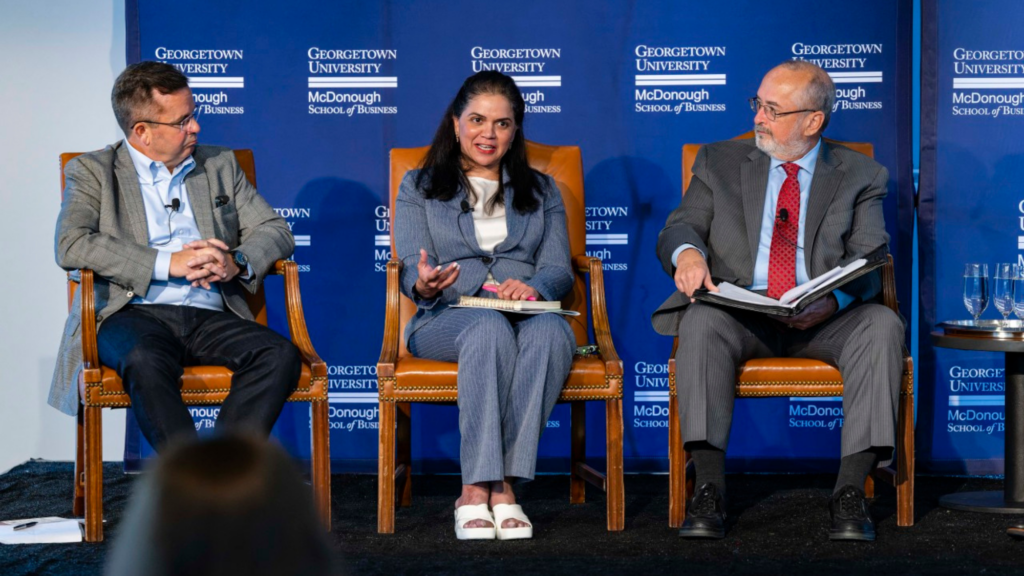Business for Impact, an initiative under Georgetown’s McDonough School of Business (MSB), held a forum discussing the nation’s medical debt crisis and possible next steps for healthcare providers and policymakers.
The Sept. 8 forum focused on a report from the Business for Impact initiative, which works to see how business can help solve social, economic and environmental challenges. The report, called “Prescription for Medical Debt: How Care Providers, Collection Agencies and Government Can Help,” identified the main causes and consequences of medical debt accumulation. Approximately 1 in 10 U.S. adults owe medical debt, with collective medical debt held by Americans amounting to aroundt $195 billion in 2019. Health expenses generated by the pandemic and recent inflation have since exacerbated the issue.
The forum was sponsored by Capio, a management company dedicated to resolving clients’ outstanding medical bills and helping them find solutions for medical debt.
The forum’s speakers included Hank Cardello, who authored the report; John McNamara, assistant director of consumer credit, payments, and deposits markets at the Consumer Financial Protection Bureau; Ashwini Kotwal, CEO of Arietis Health, a revenue cycle management company; and Mark Detrick, CEO of Capio.

Cardello, who serves as Executive Director of the Leadership Solutions for Health and Prosperity program at Business for Impact, said medical debt worsens the health outcomes of patients by disincentivizing seeking further treatment.
“One of the most insidious results of medical debt is the avoidance of routine or essential healthcare in order to avert additional medical expenses,” Cardello wrote to The Hoya. “Nearly half of the respondents (45%) in the American Cancer Society study had delayed care for a serious issue due to their medical debt.”
Almost a quarter of U.S. adults have avoided refilling a prescription due to cost, according to a 2022 study conducted by the Kaiser Family Foundation. This figure increases to 29% and 30% of U.S. adults for Hispanic and black patients, respectively.
Even medications that are essential for a patient’s survival, such as insulin, may be skipped due to the financial stress, which significantly worsens health outcomes, Cardello said.
“A recent study of diabetes patients by CharityRx found of the 60% of respondents who rationed their insulin due to medical debt, 54% reported that they couldn’t do everyday activities, 44% said they couldn’t work, and 37% said they couldn’t go to school,” Cardello wrote. “One-third reported becoming sick as the result of rationing their insulin and 38% wound up in the hospital for one or more days.
By inviting panelists and attendees across a wide range of backgrounds, the event encouraged inter-field collaboration on the medical debt problem, according to a Capio spokesperson.
“The goal of the event was to bring together a variety of healthcare industry and regulatory leaders who are on the forefront of the medical debt crisis to shed light on why medical debt has ballooned and to propose practical solutions that could help the millions of Americans who find themselves overwhelmed by medical debt,” the spokesperson wrote to The Hoya.
In addition to addressing the consequences of medical debts, panelists also discussed ways medical debt disproportionally affects some American households equally.
Medical debt is especially detrimental to certain low-income and at-risk demographics known as ALICE patients, the Capio spokesperson said.
“Too many people can’t afford an unexpected medical bill. There is a group of Americans who are commonly referred to as ALICE patients (Asset Limited, Income Constrained, Employed Americans),” the spokesperson wrote. “These individuals often have zero to negative net worth, don’t qualify for financial assistance, and when an unexpected medical debt arises in their lives, they’re often unable to afford it and fall into debt.”
Paying medical bills is something that 41% of working-age Americans, approximately 72 million people, struggle with, according to a survey by The Commonwealth Fund. The likelihood of medical debt increases 20% for low-income adults unable to afford adequate health insurance.
The spokesperson recommended passing policies that extend the time people are given to pay off debts to make the burden more manageable for patients.
Cardello said he hopes to see greater transparency with patients on how to navigate medical debt paired with substantial legislative change moving forward.
“Consumers need to be empowered with better information about how to climb out of and avoid medical debt, and industry should provide easy-to-use tools to help them,” Cardello wrote. “Legislators should establish affordable payment solutions for at-risk households that make repayment feasible without jeopardizing the family’s basic needs.”




















